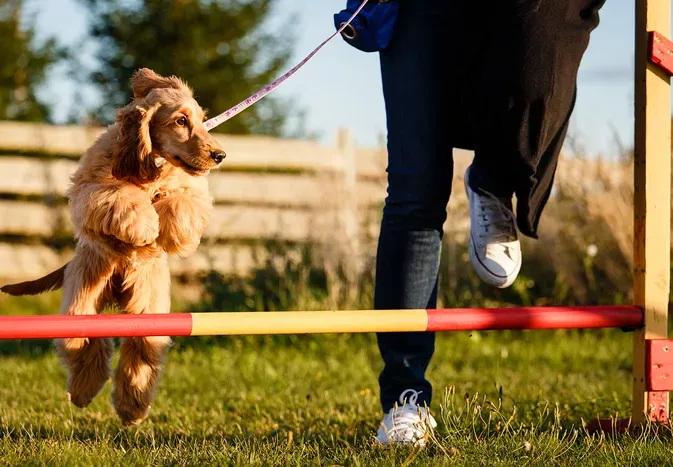How to Train Your Dog in Agility Sports
Updated on 04/26/24

Master the Art of Agility: A Comprehensive Guide to Training Your Canine Companion
Welcome to the world of canine agility, where dogs and their handlers embark on an exhilarating journey of speed, coordination, and teamwork. This exhilarating sport not only provides physical and mental stimulation for your furry friend but also fosters an unbreakable bond between you. If you're ready to unlock your dog's agility potential, this comprehensive guide will equip you with the knowledge and techniques to embark on this exciting adventure.
1. Laying the Foundation: Selecting the Right Dog for Agility
The foundation of a successful agility team lies in selecting a dog with the innate qualities and temperament for the sport. Certain breeds, such as Border Collies, German Shepherds, and Poodles, are renowned for their agility and trainability. Consider your dog's energy levels, athleticism, and disposition to determine if they possess the traits to excel in this fast-paced environment.
2. Starting Young: Early Training and Socialization
The best time to introduce agility training is during puppyhood, when dogs are eager to learn and soak up new experiences. Start with basic obedience commands and gradually introduce agility obstacles as your puppy develops confidence and coordination. Socializing your puppy with other people and animals will also help them adapt to the bustling environment of agility competitions.
3. A Guide to Agility Obstacles: Mastery and Execution
Agility courses consist of a variety of obstacles, each requiring specific techniques and handling strategies:
- A-Frame: Dogs must climb a ramp, touch the apex with their front paws, and then descend the opposite side.
- Tunnel: Dogs navigate through a closed tunnel, testing their obedience and agility.
- Teeter Totter: Dogs balance on a seesaw-like structure, teaching them to control their movement and center of gravity.
- Dog Walk: Dogs traverse a series of narrow planks, developing their footwork and precision.
- Jump Barrels: Dogs leap over a series of barrels, showcasing their jumping ability and control.
- Weave Poles: Dogs weave through a series of poles set in a zigzag pattern, requiring quick reflexes and coordination.
4. Training Techniques: A Step-by-Step Approach
Training an agility dog involves a combination of patience, consistency, and positive reinforcement. Break down each obstacle into smaller steps and gradually increase the difficulty as your dog gains proficiency. Use treats, praise, and toys as rewards to motivate your dog and make the training experience enjoyable.
5. Building Confidence: Preparing Your Dog for Competition
Once your dog has mastered the basics, it's time to start preparing them for competitions. Practice in various environments to expose them to different distractions and challenges. Encourage your dog to socialize with other agility teams and handlers to reduce anxiety. Build their confidence with successful runs and celebrate their accomplishments.
6. The Importance of Physical Conditioning and Nutrition
Agility dogs require excellent physical conditioning to maintain endurance and prevent injuries. Regular exercise, including running and jumping, is crucial. A healthy diet that provides the necessary nutrients for an active lifestyle is equally important. Consult with your veterinarian to determine an optimal nutrition plan for your agility dog.
7. Handling: The Art of Guiding Your Canine Partner
The handler plays a vital role in guiding the dog through the agility course. Effective handling involves clear communication, precise body language, and the ability to read your dog's signals. Practice running the course alongside your dog to establish a strong bond and improve coordination.
8. Troubleshooting: Overcoming Common Agility Challenges
Every agility team encounters challenges along the way. Common issues include dog distraction, hesitation, and errors. Stay positive and patient, and work through these obstacles with consistent training and reinforcement. Seek professional advice from experienced trainers or agility clubs if necessary.
9. The Rewards of Agility: Physical, Mental, and Emotional Benefits
Agility training offers numerous benefits for both dogs and their handlers:
- Enhanced Physical Fitness: Agility improves dogs' cardiovascular health, coordination, and muscle tone.
- Mental Stimulation: The challenges and problem-solving involved in agility keep dogs mentally sharp and engaged.
- Stronger Bond: Training and competing in agility fosters an unbreakable bond between the handler and the dog.
- Improved Obedience: Agility training reinforces basic obedience commands and enhances the dog's overall receptiveness to instructions.
- Socialization: Agility events provide opportunities for dogs to interact with other dogs and people, promoting socialization and reducing anxiety.
10. Finding Agility Training Classes and Competitions
To delve further into the world of agility, join a reputable agility training class offered by experienced trainers. These classes provide a structured learning environment, support, and the opportunity to connect with other agility enthusiasts. Once your dog is ready, start exploring agility competitions to showcase their skills and earn titles.
Conclusion
Embarking on an agility journey with your canine companion is an incredibly rewarding experience that will strengthen your bond, improve your dog's physical and mental well-being, and create lasting memories. With the right training, dedication, and a touch of patience, you and your dog can master the art of agility and achieve remarkable accomplishments in this exhilarating sport. Remember, a well-trained agility dog is a happy, healthy, and fulfilled furry friend who will cherish the adventures you share together. So, unleash your dog's inner agility superstar and embark on this exciting journey today!
Explore More Pets

Basic Training
Puppy and Baby Introductions

Working Dog Breeds
All About Search and Rescue Dogs

Dog Treatments
Puppy Vaginitis: Signs, Causes and Treatment

Dog Adoption
After More Than 1,200 Days in the Shelter, Coco Goes Home

Basic Training
How to Train Your Puppy to Go on Potty Pads

Hybrid Dog Breeds
The Difference Between a Mutt, Mixed Breed, or Designer Dog?

Dog Treatments
Nail Problems in Dogs

Puppies
7 Reasons Why Two Dogs Are Better Than One